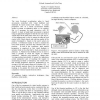89 search results - page 7 / 18 » Trajectory Based Assessment of Coordinated Human Activity |
ISBRA
2007
Springer
14 years 1 months ago
2007
Springer
The fundamental goal of computational neuroscience is to discover anatomical features that reflect the functional organization of the brain. Investigations of the physical connect...
CHI
2000
ACM
13 years 11 months ago
2000
ACM
The term Eye-hand co-ordination refers to hand movements controlled with visual feedback and reinforced by hand contact with objects. A correct perspective view of a virtual envir...
IOT
2010
13 years 4 months ago
2010
Effectively assisting people in complex and highly dynamic work environment requires advances in high-level declarative activity models that can describe the flow of human work act...
COORDINATION
2005
Springer
14 years 1 months ago
2005
Springer
Architectural descriptions can provide support for a formal representation of the structure and the overall behavior of software systems, which is suitable for an early assessment ...
AROBOTS
2008
13 years 7 months ago
2008
Online trajectory generation for robots with multiple degrees of freedom is still a difficult and unsolved problem, in particular for non-steady state locomotion, that is, when th...

